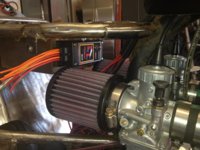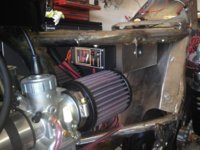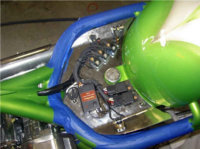I added the VR115 regulator and RadioShack rectifier mod to my on going tracker project. Both wired accordingly with a 4 atc fuse holder block. Original starter relay, original switch gear, and needed wiring. Running a Shorei battery and 55'60 halogen headlight and 1157 taillight. Sell me. Why should I run your setup instead posplayr?
Dave,
Even though you have tried to keep your electrical to a minimum, you can still benefit from the SSPB. After an install:
1.) There will be much less current running through both the Ignition switch and the Kill switch so you will have higher voltages to the coils for improved running (assuming it is too low in the first place). It will also stay that was even if your Ignition and Kill switch crud up as there is essentially very little current flowing through. This is equivalent to having an mechanical relay connected to both the IGN SW and Kill SW.
2.) Assuming electric start, you will have 5 more amps available for cranking because of the headlamp cutout. If you have kick start there is an easy modification to switch the headlamp off during start up. You need a switch through, but the switch doesn't flow any current at it is the same deal as item #1) above. This is equivalent to having two other relays, one to power coincident with the IGN and one to cut out the headlamp with the START button.
I recently ordered a 55 Watt HID to see what happens on start up. As long as it stays below about 12 amps or doesn't mind being limited to 12 amps all will be ok. It should drop to about 3-4 amps while running which is fine. The specs I have been reading typically show spikes to 6 amps during start up but I have not seen any data yet.
The SSPB will also run fine with any combination of Incandescent and LED lights.
3.) If you need to add another accessory, there is yet another solid state channel (equiv of a mechanical relay) that you can setup either to power from IGN or +12V switch or a GND switch.
4.) You don't have to ever change any fuses nor worry about a fuses corroding and shorting out the fuse box when they get hot.
5.) The SSPB delivers "Safe Power". Assuming you route all power through it, you can short wires indiscriminately and it will not blow a fuse. As soon as the shorts are removed full operation is restored without any power resets, breakers or anything else. When there is an over current you will get an audible warning and a flashing red LED until it is gone. The unswitched power has the same protection.
6.) The SSPB is designed with a triple layers or protection against conducted emissions. That means that any current spikes over about 24 volts get suppressed (shunted to ground) by the SSPB. It can handle +/- 100 volt spikes including reverse hook up to the battery. The ability to suppress those spikes means that anything in parallel to the SSPB (either on the input or the output is also protected in the same way. So any sensitive electronics such as R/R's (connected to the input) or Ignition systems (connected to the output) has the same protection.
6.) Apparently the XS650 and it's alternator have some type of voltage kick back when shutting off as evidenced by the 20 amp fuses as well as some of the XS650 owners observations. The SSPB will suppress those negative going pulses.
7.) If you need to add any power devices to your bike, the SSPB provides safe and low loss control of those circuits. (1 un-switched and 4 switched)
8.) If you need to control your power for such things as an Alarm, and you dont have an ECU disable, the SSPB provides an easy way to disable either the Entire SIGNAL Circuit or just the IGNITION circuits.
9.) I have pretty much ignored most of the technical design details about why the SSPB is a optimum power distribution solution using the reliability and flexibility of modern solid state automotive grade electronics, but that is also a reason.
The Bottom line is that , in a small and very robust form factor the SSPB becomes the foundation for our bike's electrical system. It is the foundation from which to run and add the various elements while being trouble free and reliable with virtually none of the problems associated with the original design.
Hope that helps.


 I have been busy today trying to get the shop together, last on the list aparantly when moving so I am informed! It does look like tomorrow I should be able to complete the job.
I have been busy today trying to get the shop together, last on the list aparantly when moving so I am informed! It does look like tomorrow I should be able to complete the job.

